May 23rd, 2006
Nottingham was calculated to have 115.54 crimes overall, followed by Leeds, with 107.22, Stockport, Greater Manchester, with 100.42 and Bradford, with 100.4. [ per 1 000 of population ]
The BBC News article based on the reaction to a report on crime rates in large urban areas by the think tank Reform highlights the perils of geographically distributed statistics. At what level do you collect figures? How do you average figures over larger areas?
Posted in Maths | Comments Off
May 19th, 2006
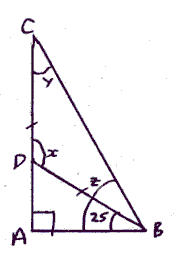
This question or one very similar cropped up in a revision exercise today. There are three triangles in the figure, ABC is a large right angled triangle, ABD is a smaller right angled triangle and DBC is an isosceles triangle. The solution is along the lines that angle ADB must be 65 degrees as the small triangle DAB has 90 + 25 degrees used up already. Therefore, X is 180 – 65 from the ‘angles on a straight line add to 180’ rule. However, angle X is also the apex angle of the isosceles triangle DBC, so angle DCB and angle DBC are both equal and must be equal to half 180 – 115 or 32.5 degrees. Finally the angle CBA, labelled Z, must be 32.5 + 25 = 57.5. Angle Z could be calculated from the large triangle ABC from 180- 90 – 32.5.
Most students get the hang of these little puzzles quite quickly and actually get to enjoy them. I usually liken them to playing draughts when you hop over about 7 or 8 pieces and take them all, these problems provide easily explained examples of a chain of reasoning. Geometry also has the feel of things fitting together because there is only one way they can which might be mentally attractive in these days of constant change and flux (two of our extended group of students were recently made redundant; the College is now rather more important to these two than previously as they explore new skill sets).
Some students find the ‘refocussing’ needed to ‘see’ the three triangles in the diagram difficult. These students also need to be prompted to look at the triangle with the most information in first – ie ABD as there are two known angles in that triangle. Based on a small sample (5 students spread over three classes) these students also seem to have problems with ‘if…then’ constructions, such as ‘if I know the apex angle in the isosceles triangle, I can find the value of the two equal sized angles’. I have taken to asking ‘how many triangles are there in this diagram’ when introducing problems of this type, and that seems to help. Diagram snapped from a doodle on paper and processed with scanr.
Posted in Maths | Comments Off
May 17th, 2006
Imagine living in a flat that was 100 square feet in size. Communal toilets and showers I suppose, but what about the cooking? They seem to have flasks but no stoves so perhaps there is a communal kitchen. No sign of ‘a room of one’s own’ here.
Michael Wolf is showing us part of the living arrangements, but not the whole support system: do the people keep their doors open and live communally by floor, so the corridor becomes a street, or do they keep the doors closed most of the time? We only have one word of the pattern language that must describe the flats.
Posted in Notes | Comments Off
May 16th, 2006
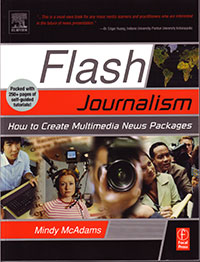
The book arrived today. Published in 2005 the screen shots are taken from Flash 2004 MX, but the Web site for the book is promising updates for Flash 8. Page 208, exercise 8.7 deals with ‘synchronising images to loaded audio’. The deal for me is to pull out MS PowerPoint slides and vector drawings as illustrations to a sound track…
Example 14 on the Web site is a short light weight flash movie that synchronises a series of drawings to the sound track. Nice.
Posted in ILT | Comments Off
May 16th, 2006
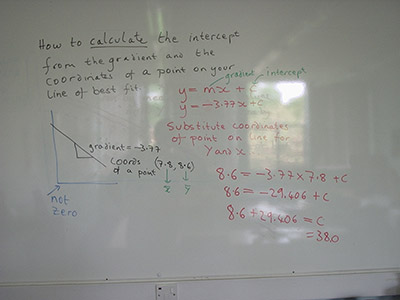
We were looking at finding a value for the intercept of a straight line graph when the scale of the graph made it difficult to have an X axis that started at zero – we were setting up and solving a simple equation within a context.
This second whiteboard processed using ScanR was taken in a difficult room with windows facing the whiteboard and bright reflections. ScanR is a Web based service that processes your mobile phone pictures of whiteboards or documents into PDF files, see Monday’s post for details. Much to my surprise, the reflections were not a problem – it was the edge detection that proved problematic…
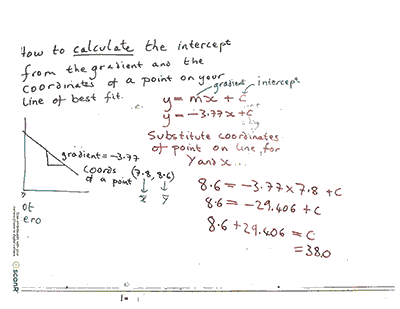
ScanR seems to have taken the graph Y axis as the edge of the whiteboard and ignored marks to the left. Another shot taken at an angle (originally taken to avoid bright reflections) happened to include the edge of the whiteboard and wasn’t cropped….
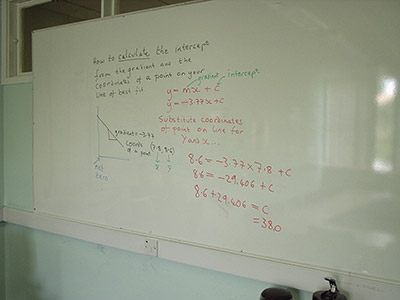
As the left edge of the whiteboard is visible, this is processed by ScanR as follows…
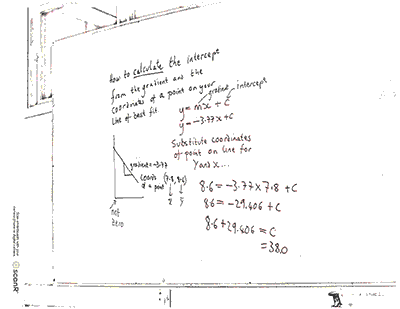
This scan can be exported from the Mac OS X Preview application as a TIFF and cropped if needed. All the images above have been resized in Photoshop Elements to 400 pixels wide – the originals had higher resolution.
The moral is: don’t worry about reflections, ScanR can deal with those very well, just make sure there is a frame or edge to the whiteboard work so that ScanR can pick up the true extent of the image.
Posted in ILT, Maths, Web | Comments Off
May 15th, 2006
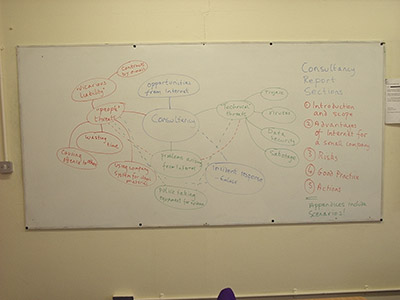
The photo above shows one of today’s whiteboards as imaged using my Olympus Camedia point and shoot – the images are 1600 by 1200 pixels. I resized the image above using Photoshop Elements with bi-cubic resampling. No other adjustments have been made, the flat image is typical of this camera. A quick e-mail to ScanR.com produced a clear high contrast PDF file….
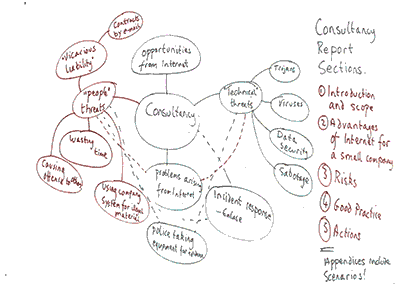
This image was cropped from the PDF file from ScanR.com using the Mac OS X Tiger Preview application and then exporting the cropped image as a TIFF file from Preview. I dragged the file into Photoshop Elements and resized to 400 pixels wide and then used the Save for Web option to produce the gif file. The PDF file weighs in at 250Kb versus 500+ Kb for the original jpg file from the camera, and I had no problem popping the pdf file direct from ScanR onto the course blog for the benefit of students not able to attend. I would not normally bother to produce the scaled down thumbnails – just pop the PDF on the system for the students.
I think that ScanR may be a useful service for capturing negotiated content like this (the map was built up from the suggestions of students – the list of headings for the structure of a major piece of writing was agreed after discussing the bubble chart) for future use and for popping into VLE and/or PowerPoints.
Posted in Forensic, ILT | Comments Off
May 14th, 2006
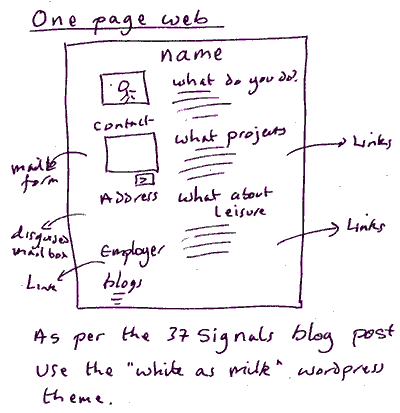
Scanr is a Web service that claims to “convert photos of whiteboards and documents into searchable PDF files”. The ‘searchable’ bit applies to pictures of documents with typed text (see later). The service certainly makes converting fuzzy badly lit images of (ordinary) whiteboards more readable. The ‘whiteboard’ function can also be used to convert images of flip-chart pages and doodles on scrap paper as shown above. The image above was acquired on a 1600 by 1200 pixel camera in macro mode. I sent the image straight from the camera flash card to scanr as a jpeg file and a few minutes later I received an e-mail with the PDF file enclosed. I then converted the main part of the doodle to PNG in Preview and scaled the image down to 400 pixels wide in Photoshop. I could just upload the PDF file, about 250Kb which is half the file size of the original jpg file produced by the camera. These are quite large files and students who are on modem connections might not appreciate having to download half a dozen whiteboards from Moodle each week!
You can use the ‘document’ service to process images of pages from newspapers and books; below is a detail of a page from Hypertext 3.0 by George Landow as rendered by scanr. The scan preserved my comments in the generous margin of Landow’s book, not bad for a quickly taken photo – this image is reproduced actual size from the scanr.com output. The real bobby dazzler is that the text is searchable from within the PDF file: on Preview on my iBook, I just searched for ‘blog’ using the Edit | Find command, and all the occurrences of ‘blog’ appeared in the search results pane. So you can use your phone camera to do limited OCR on printed text. On a Mac OS X computer running Tiger, Spotlight will pick up words in these searchable PDFs so that your photos of newspaper articles, posters, planning notices stuck on lamp posts and so on can be found again in a few months.
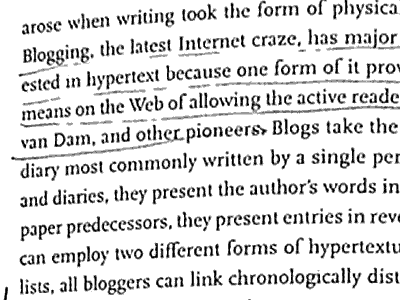
Perhaps I’ll be capturing a range of whiteboards next week to see how scanr copes with hotspots caused by flash, sunlight and general grungy-ness. There are a number of these Web based services around now, to-do lists, calendars, blogging systems, photo sharing sites, file sharing sites and even a site where you can print customised note paper. Increasingly we can place data online instead of keeping it locked up on our computers.
Posted in ILT | Comments Off









